As usual, Mary Lou walked up ahead of me on the gravel road while I took a few "shots in the dark..." well, semi-darkness. She continued the full 1 1/2 miles into the wetland preserve and then returned home at her customary fast pace while I lingered at the lake. An immature Little Blue Heron hunted along a row of spike-rush. Under-exposed, I liked the color cast by the filtered light of dawn in the still air.

This Osprey was silhouetted against the sky, and when I processed the shot I had to push the brightness all the way up.
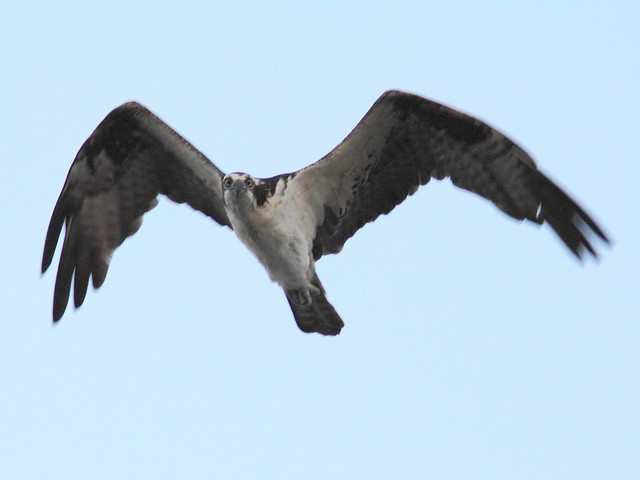
I kept vigil, hoping I had gotten there before the crane departed for its foraging grounds. Looking towards the Everglades, to the west over the lake, the sky had a pre-dawn glow. I tried to overlook the deep tracks in the mud flats, created by the recreational ATV riders. The crane usually spent the night in a wet prairie just in front of the green trees to the far right in this photo.
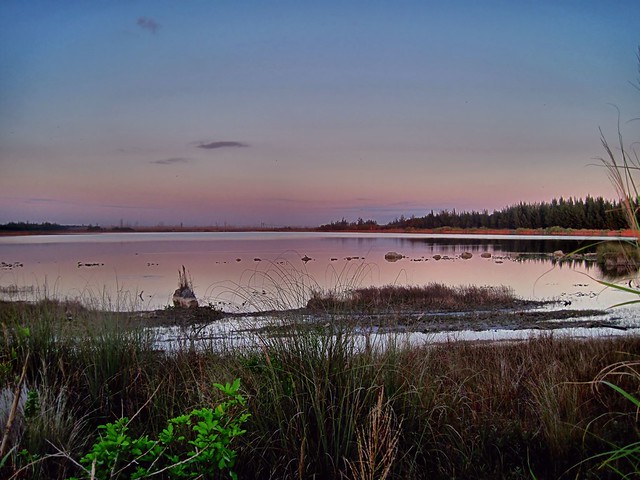
My cell phone rang. It was Mary Lou, telling me that she had met two wildlife specialists at the entrance gate, Jeanette and Ricardo, from the Whooping Crane Eastern Partnership. They were asking about the crane. She related that I was about 1/2 mile up the gravel road, looking for it. The gate was locked and they could not access with their truck, so they rode their bicycles in.
On the way in, they picked up the signal from Cypress-- in the direction of Scott's home. Jeanette was carrying the receiver and antenna when she pedaled towards me. (That's the burnt-out area formerly known as my "Fake Hammock" just behind her. View "Birding in a make-believe hammock.") This crane did not carry a satellite locator, so ground reports were important to allow the researchers to know the general area in which they might track it with the short-range equipment.

I texted Scott and he confirmed that the crane was indeed on his front lawn. We entered the Harbour Lakes subdivision and encountered the crane just across the street from Scott's house.
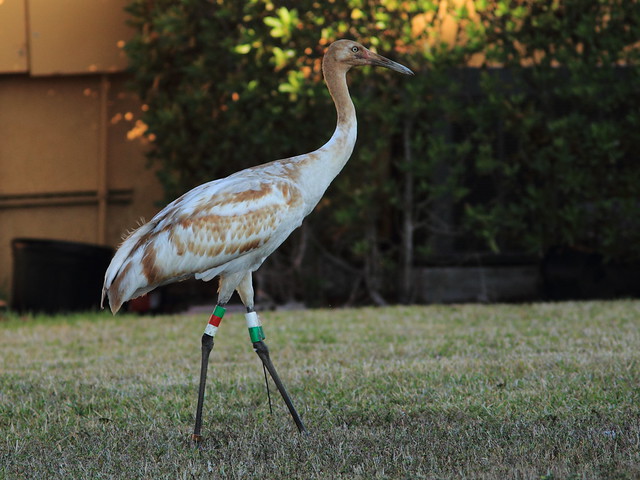
Jeanette spent over an hour gaining the crane's confidence. Several times it appeared spooked when pedestrians and especially those walking dogs came by. She fed the crane green grapes and corn.
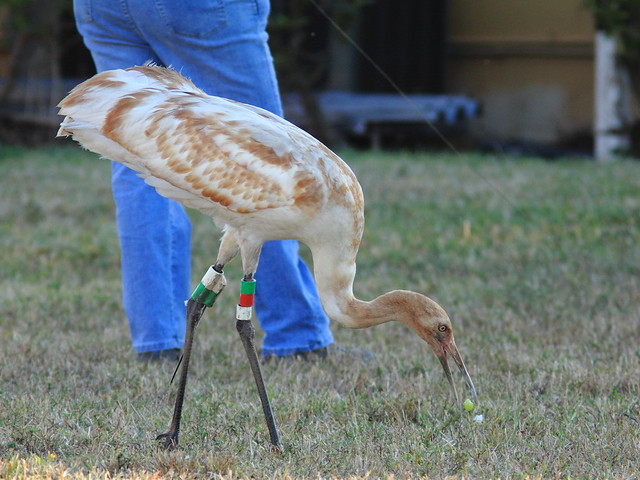
Cypress stepped in and out of the snare but Jeanette wanted a perfect capture. Her body language calmed the crane. She never walked directly towards the bird, but rather approached it at an angle and usually looked away from him.
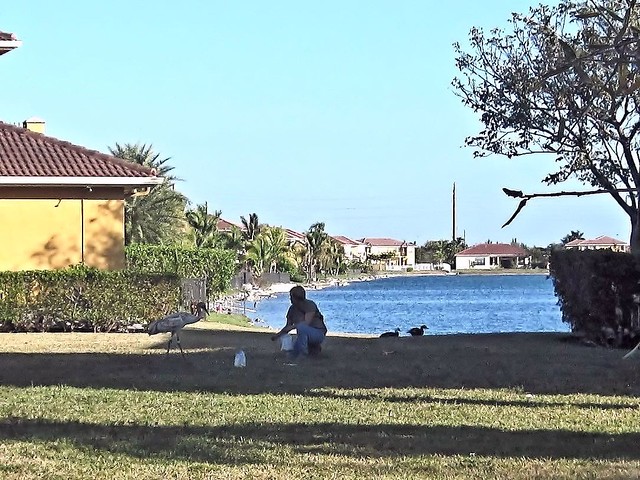
Several feral Muscovy Ducks and White Ibises joined in the feeding. Auto traffic increased as parents transporting children to schools and commuters heading to work moved by rapidly. We had to divert pedestrians, as the crane showed signs of being alarmed and prepared to fly. Then, the crane started walking away, across the road.
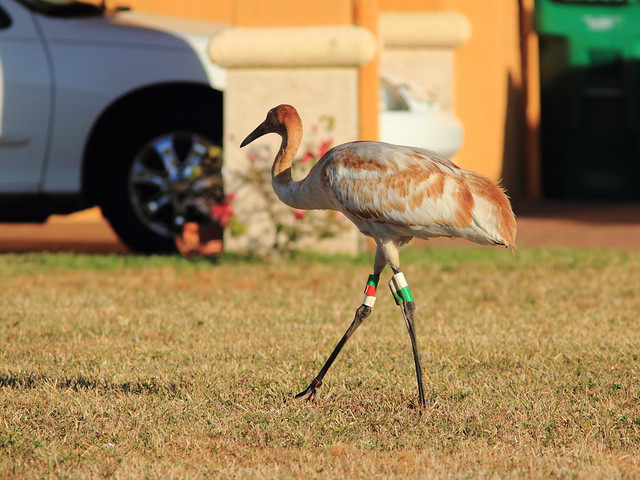
Jeanette then donned a white sheet similar to that used when the cranes are reared, as it hides the human form.
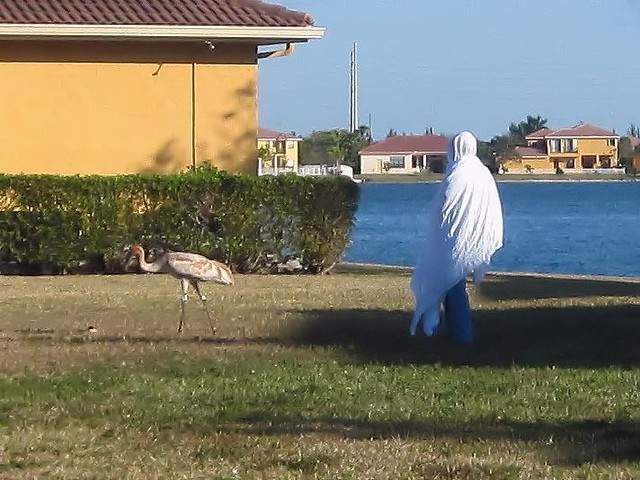
The crane actually came running to her! Within minutes the crane was captured. Here is a short video showing the entire sequence of events (Correction-- my lens system is 420 mm, not 720 mm-- I use a 300 mm + 1.4x extender).
Scott took this photo of Ricardo and Jeanette at the conclusion of the capture. It is ironic that it was Scott who first photographed the crane after its arrival in the wetlands, and now he took the final photo to document its departure. (© 2013 Scott McPherran, used with his permission).
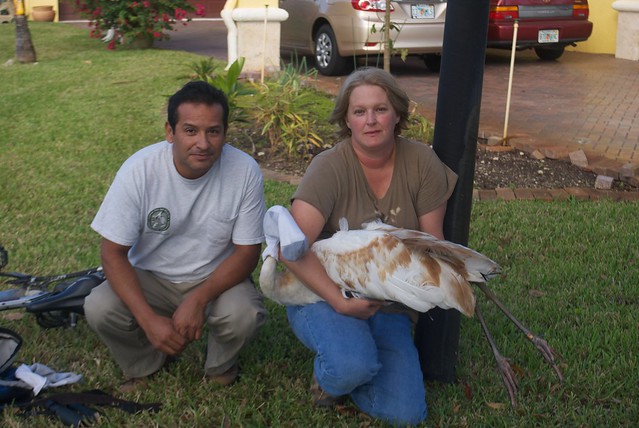
Soon Cypress was safely on his way to join a mixed flock of adult Whooping and Sandhill Cranes in the Lake Okeechobee area. Click here for the latest update on the status of the eastern migratory flock.
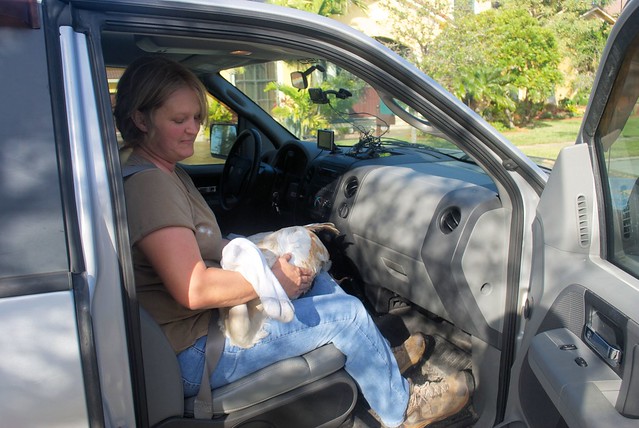
The female crane #13-12 ("Tussock") recovered and was earlier released in Tennessee (See the interesting local newspaper account here). A US Fish and Wildlife news release with a video link may be viewed here. While I am excited about the possibility that an Eastern migratory population of Whooping Cranes may be established by this program, I must admit to some concerns about this captive-bred crane. These birds are shielded from human contact while they are raised. They are fed using crane puppets and not exposed to human handlers unless the latter are draped in white sheets to hide their identity. (View WCEP slide show on training captive cranes.)
Perhaps it would be better if they learned to fear humans at some point before being released into the wild. These two birds permitted many people to approach them very closely, including youngsters on ATVs. Lacking fear of humans, they visited suburban lawns and even walked up to people. Might it have been a good idea to teach them that humans should be avoided? What if the first people they saw shot off firecrackers or clanged pots and pans to frighten them? Perhaps this would discourage them from approaching human habitations, and yet permit them to adapt to a more urbanized winter habitat.


very interesting. I do hope it will find peace and contentment where it is taken to mix with others of its own kind. The transmitter on its leg appeared quite cumbersome, I wondered if it mightn't have had potential to get hooked up on something? Thanks for your informative post.
ReplyDeleteGreat pot and photos, Ken! Glad the Whooping Crane is safe now!
ReplyDeleteAmazing story. Brings up a lot of questions.
ReplyDeleteHOLA A TODAS Y TODOS PIDO PERDÓN POR NO HABLAR INGLES,ME GUSTARIA SABER COMO FORMAR PARTE DE BIRDING Y DE LA LISTA DE BLOG,ENHORABUENA POR VUESTRO TRABAJO AQUI OS DEJO MIS DOS BLOGS PARA QUE LOS VEAIS,GRACIAS DESDE PAMPLONA-ESPAÑA
ReplyDeletehttp://avesdelcielo.blogspot.com.es/
http://volandoconbuitres.blogspot.com.es/
HELLO JOSÉ MIGUEL --
ReplyDeleteI enjoyed your blogs. The Hawfinch was an exciting find, and it is sad to learn of the plight of El Guirre in the canary Islands.
I do not speak Spanish but Google helped me. If you mean you would like to be listed on "Birder Profile," which is a weekly blog segment at "Birding is Fun!" spotlighting a fellow birder, you could share a little about yourself and your birding experiences. If so, please send an email to Robert Mortenson at Enthusiasm for birding is the only prerequisite!
HOLA JOSÉ MIGUEL -
Disfruté de sus blogs. El Picogordo fue un hallazgo emocionante, y es triste al enterarse de la situación de El Guirre en las Islas Canarias.
Yo no hablo español, pero Google me ayudó. Si te refieres a que le gustaría ser incluido en el "Birder Profile" ("Perfil Birder"), que es un segmento semanal en el blog "Birding is Fun!" pone de relieve una birder compañero, puedes compartir un poco sobre ti mismo y tus experiencias de observación de aves. Si es así, por favor envíe un correo electrónico a Robert Mortenson en Entusiasmo para la observación de aves es el único requisito!
Thrilling account and video, Ken! I agree with you about the need to instill fear, or at least aversion, to humans and am surprised that this wasn't done.
ReplyDelete